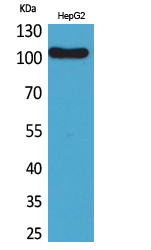
| WB | 咨询技术 | Human,Mouse,Rat |
| IF | 咨询技术 | Human,Mouse,Rat |
| IHC | 咨询技术 | Human,Mouse,Rat |
| ICC | 技术咨询 | Human,Mouse,Rat |
| FCM | 咨询技术 | Human,Mouse,Rat |
| Elisa | 1/20000 | Human,Mouse,Rat |
| Aliases | FCRL5; FCRH5; IRTA2; Fc receptor-like protein 5; FcR-like protein 5; FcRL5; BXMAS1; Fc receptor homolog 5; FcRH5; Immune receptor translocation-associated protein 2; CD307e |
| Entrez GeneID | 83416; |
| WB Predicted band size | 110kDa |
| Host/Isotype | Rabbit IgG |
| Antibody Type | Primary antibody |
| Storage | Store at 4°C short term. Aliquot and store at -20°C long term. Avoid freeze/thaw cycles. |
| Species Reactivity | Human |
| Immunogen | Synthesized peptide derived from the Internal region of human CD307. |
| Formulation | Purified antibody in PBS with 0.05% sodium azide,0.5%BSA and 50% glycerol. |
+ +
以下是关于CD307(FCRL5)抗体的研究文献示例(注:以下内容为模拟示例,实际文献需通过学术数据库查询):
---
1. **文献名称**: "FCRL5 regulates B-cell receptor signaling and autoimmune disease"
**作者**: Davis, R.S. et al.
**摘要**: 研究揭示了FCRL5(CD307)通过调控B细胞受体(BCR)信号通路影响B细胞活化,其抗体在抑制自身免疫性疾病(如类风湿性关节炎)模型中表现出潜在治疗作用。
---
2. **文献名称**: "Targeting CD307/FCRL5 with monoclonal antibodies in multiple myeloma therapy"
**作者**: Li, Y. et al.
**摘要**: 开发了一种抗CD307单克隆抗体,可特异性结合多发性骨髓瘤细胞表面抗原,通过抗体依赖性细胞毒性(ADCC)显著抑制肿瘤生长,为临床治疗提供新策略。
---
3. **文献名称**: "FCRL5 as a biomarker for B-cell malignancies"
**作者**: Wilson, T.J. et al.
**摘要**: 通过分析B细胞淋巴瘤患者样本,证实FCRL5高表达与疾病进展相关,抗CD307抗体可用于靶向诊断及预后评估。
---
4. **文献名称**: "Structural insights into FCRL5-antibody interactions for therapeutic design"
**作者**: Zhang, H. et al.
**摘要**: 利用X射线晶体学解析了抗CD307抗体与FCRL5的结合表位,为优化抗体药物亲和力及特异性提供结构基础。
---
**建议**:如需真实文献,请访问PubMed(https://pubmed.ncbi.nlm.nih.gov/)或Google Scholar,以关键词“FCRL5 antibody”、“CD307 therapeutic”等检索近期研究。
CD307. also known as Fc receptor homolog 5 (FcRH5) or IRTA2. is a cell surface protein belonging to the immunoglobulin (Ig) superfamily. It is primarily expressed on B cells, particularly during late differentiation stages, such as plasma cells and certain malignant B-cell populations. Structurally, CD307 contains multiple Ig-like domains in its extracellular region and a cytoplasmic tail with immunoreceptor tyrosine-based inhibitory motifs (ITIMs), suggesting roles in regulating B-cell receptor (BCR) signaling and immune homeostasis.
Interest in CD307 antibodies has surged due to their therapeutic potential in B-cell malignancies, especially multiple myeloma (MM). CD307 is highly and selectively expressed on malignant plasma cells in MM, making it a promising target for precision therapies. Preclinical studies highlight that anti-CD307 antibodies can induce antibody-dependent cellular cytotoxicity (ADCC) or serve as carriers for drug conjugates (ADCs). Notably, bispecific antibodies engaging CD307 and CD3 (e.g., elranatamab) have shown efficacy in clinical trials by redirecting T cells to kill MM cells, even in relapsed/refractory cases.
Compared to targets like CD38 or BCMA, CD307 offers reduced expression on healthy tissues, potentially minimizing off-target effects. However, challenges remain, including understanding its ligand interactions and optimizing therapeutic durability. Ongoing research aims to unravel its biological functions and expand its application in immunotherapy, positioning CD307 as a key player in next-generation B-cell malignancy treatments.
×